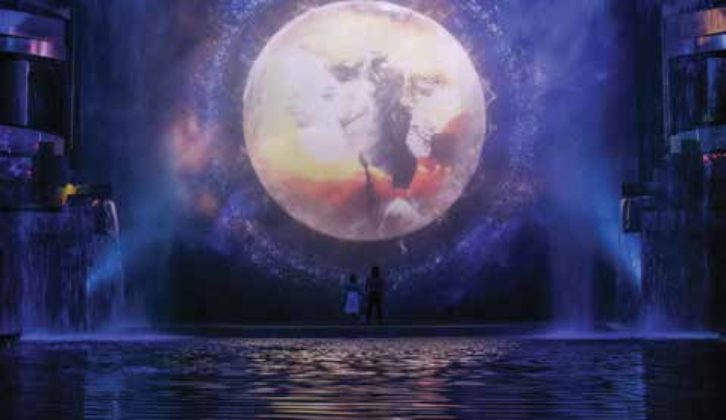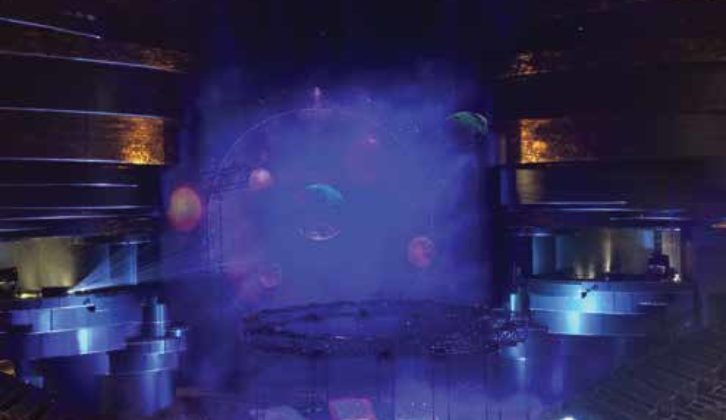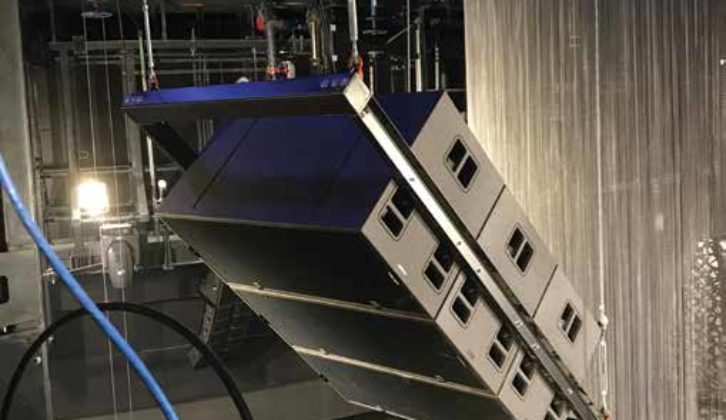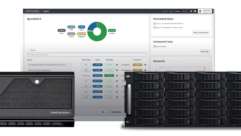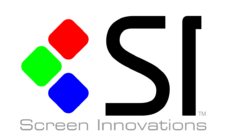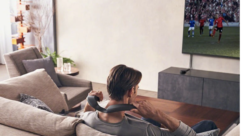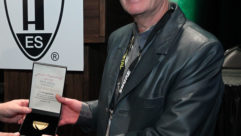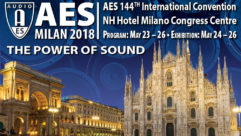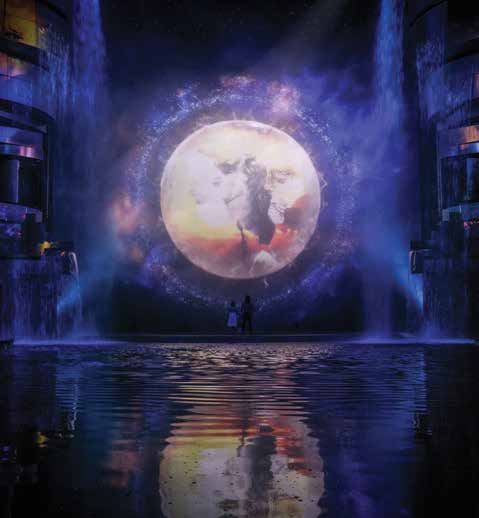
“Once we were appointed, the system design evolved along with the creation of the show,” says Bob Barbagallo, Solotech’s vice president, project development. “We proposed Kara for its clarity, intelligibility and compact, lightweight design, with the SB28s and SB18i subs selected for low end reinforcement and 12XTs added for high surround in the second ring. We also had several rigging challenges which Kara’s rigging system helped simplify during the installation.”
In high-end themed environments, audio often must accept its role as unsung hero, coexisting with other, more visual and needier systems. These days, modern, immersive, circus-inspired theaters are the ultimate example of that, incorporating dramatic lighting and audio, often water, fire, and most importantly rigging and life safety systems, for performers. And that’s in addition to all the normal obstacles presented by architecture and HVAC. As these spectacles continue to push creative limits, and as theaters are purpose-built to host them, an interesting thing is happening in audio. Even as sound system designers wrangle the practical logistics of systems design and installation, they are engaging more with audio as a creative and spatial tool, pushing new possibilities to shape experience and space with sound.
La Perle by Dragone lives in a massive theater on the Sheikh Zayed Road in Dubai’s Al Habtoor City. A cast of 65 artists perform aerial and aquatic stunts, working high above—and diving into—an onstage pool. The theatre is not only vast, but complex; the audio shares space with automation lines, water pipes, and nozzles for water effects, as well as lighting, projection, and rigging.
Franco Dragone was one of the creative minds behind Cirque Du Soleil. In 2000, he set up his own company, which has built spectacular shows worldwide including Celine Dion’s Las Vegas residency, The Dai Show, The Han Show, and The House of Dancing Water in China, Le Rêve in Las Vegas, and Lido Paris Merveilles in France.
La Perle, which opened 5 months ago, is one of his most ambitious projects to date and was five years in creation. Dragone conceived the audio design in collaboration with longtime system design partner Solotech, Dragone’s partner in The House of Dancing Water and Le Rêve. When La Perle was in its initial stages, Solotech’s integration division was introduced to Al Habtoor by Dragone to provide integration support and equipment for the complete multi-channel sound reinforcement and video systems for the theatre, as well as all onsite installation supervision, labor, project management, and logistics, says Solotech VP of project development, Bob Barbagallo.
The audio design is based around a compact LAcoustics Kara system, chosen in part for its waterproof rating. During production, the introduction of L’Acoustics’ new Syva colinear source system brought another important creative opportunity to the room, says Sebastian Hammond, head of sound for Dragone.
“My aim was always to make this a completely immersive experience,” Hammond explains, “I wanted to detach the audience from the world and their daily lives right from the moment they walk into the theatre.” To that end, Hammond even used a simple QLab multimedia playback cue software to start the soundscape experience right from the preshow.
Inside the main theater, 1300 audience members face off across the stage and pool, where they are surrounded with video, lighting, water effects, and a score that ranges from intimate acappella to drums and thunderstorms.
“It’s a beautiful theater,” Hammond says, with acoustic pros and cons. “There are bass traps around the building, and large amounts of fabric. But the walls are perforated metal; l was quite concerned about this; I was imagining the high frequency on the panels would be an absolute nightmare. But the installation and absorption behind the perforation works amazingly well. It’s a big space as well. These venues can only be compared to arenas for a space this big, it sounds really good.”
The main system over the wet stage comprises left, right, and center hangs of six Kara topped with an SB18 sub, plus two further hangs in the same configuration sitting on either side of the proscenium to create a wide stereo image. Adjustments to the original design were made during the installation to take account of the reality of the theatre, ensuring clearance of winch lines and water effects, with the four LA4X and 19 LA8 amplified controllers driving the system from a rack room to isolate them from moisture. The Kara’s IP55 rating affords it protection against the water jets.
“In the early days of water system testing, I was sitting at my desk and out of the corner of my eye, I see a rain nozzle spraying full pressure straight into the front of a Kara array,” recalls Hammond. “This is always a risk in these environments, rain nozzles can get unfocused, and it can be devastating—we have lost self-powered speakers in the past. I called Julien Laval at L-Acoustics and said, ‘a rain nozzle fired straight into the cabinet.’ He assured me the speakers would be fine once the array had dried. That seemed to good too be true. But I ran Smaart through the system the next morning to see if there were any issues and it was just like new! This is a huge bonus for an environment like this.
“One fantastic thing is they’re not self-powered, so I don’t have amps in the air with all that water. It’s very nice to have the amps in a climate-controlled rack room on grid level where it’s easy to get to them.
As a whole, the system has provided everything needed of it, with LA Network Manager deployed to look after processing requirements, which the team has found straightforward and easy to use. The ‘fallback’ mode featured on the LA4X and LA8 amplifiers has also been welcome; AES inputs are used in show mode, and if there is a problem with the AES side of the system, ‘fallback’ can be triggered to switch seamlessly to the direct analog runs. “When you’re designing you need to think of your backup plans and backup systems and this is a really valuable one. We had to just make sure we could do the analog tie lines and AES tie lines,” Hammond notes.
The system also comprises BSS for matrixing and routing between the DiGiCo FOH console and the amplifiers. A combination of various weather-rated Meyer Sound fills and surrounds round out the Hammond’s sound system palette.
“I can’t speak highly enough of my tools. I’ve been impressed with how much output and power I get from the Kara for the size and weight of speaker. They don’t require much work to sound great.”
But ultimately, Hammond says, the tools exist to serve the immersive experience and the job is to be fluent and flexible in supporting the show’s content and creators. “The biggest thing when you’re designing these shows, especially with Franco—he’s a true artist—is he really creates with the inspiration he has from the people around him. It makes the creation period such an evolving thing. It can completely change directions from one moment to another. You really need to design with flexibility in mind.” And serendipity. For Hammond one of the most revelatory discoveries was essentially an accident.
During the installation, Hammond needed to add an image to a critical set piece—a large drawbridge that splits the audience. Architecturally, it did not allow him much space to fit loudspeakers. “It was a small space and I needed a big image,” he recalls. “I was lucky that Syva became available from L-Acoustics at just the right time. It’s shape and compact size made it the perfect fit for the design limitations and the sound exceeded my expectations; it’s got great power and clarity and we can get a throw of up to 30 meters, and it’s consistent with Kara, so we could use Syva to extend the image of the main system.”
Once the two Syva units were installed to support the drawbridge and Hammond started incorporating them into the mix, he started finding creative options that went well beyond the immediate sound imaging.
“The show is music heavy and sound effects heavy, very immersive,” he explains—there are video projections of mountains, forest, thunderstorms. We create and place soundscapes to surround and immerse the audience—the music is so layered; there can be a lot of instruments. So we are already unconventional in how we use a multi-channel system,” he says. Syva was another way to open the mix up and spread things out even more—shaping the stereo imaging and making it bigger. “At first we were focused on imaging the set piece, but when we started receiving music from the composer and placing things around the room we started to experiment, especially with strings and horns.”
Because the Syva matched the Kara so well, he says, he could mix the Syva into the total mix—not just to image the drawbridge. “Normally, the further back you get in the theater, the stereo image starts to get smaller, so when we added the Syvas I could open things up quite a bit, even for people sitting quite far back. This was the first time I had the chance to push the limits there. I’ve been able to push how the system is used musically, not just for expanding reverbs and sound effects.”
Another workhorse tool in Hammond’s sound palette is QLab, which doesn’t just serve in the preshow space and for backup and emergency. Because it can follow timecode (from the bandleader), the inexpensive software also allows sound effects to follow content. “For example, there’s a network connection between the video system and our QLab systems, to sync video effects with sound effects. For a moment in the show, there is a flame effect from where the high divers enter the water that can exactly sync the image and sound.
All this, he says, sparked ideas for future designs and future projects and gave him yet another way to deliver on the flexibility that Dragone demands. “You never know what can be asked of you.”
